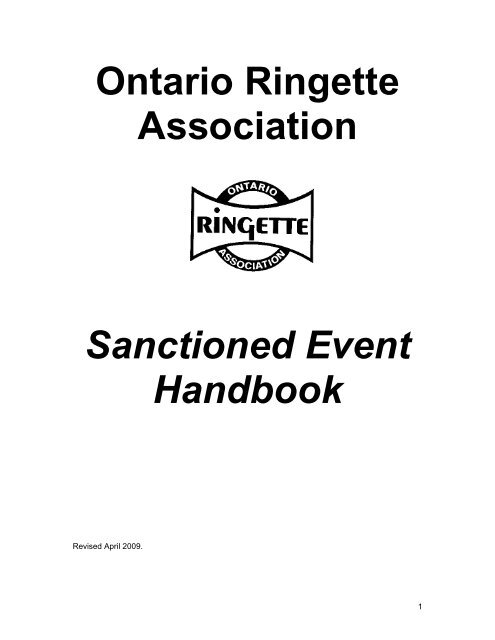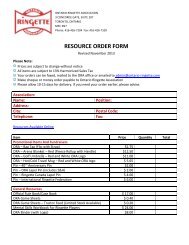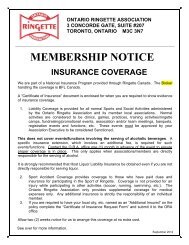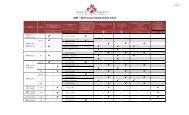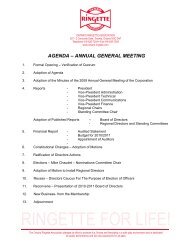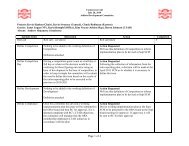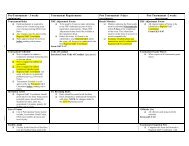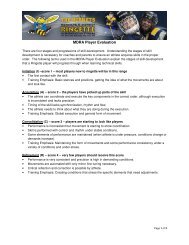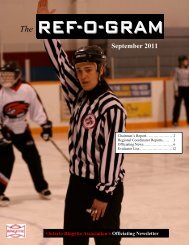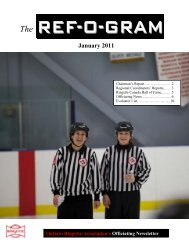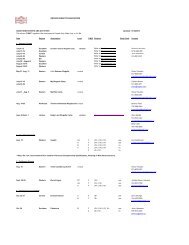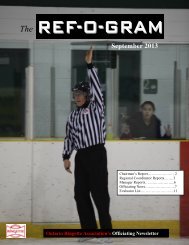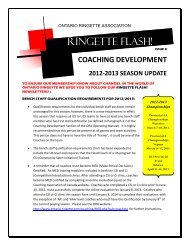Sanctioned Event Handbook - Ontario Ringette Association
Sanctioned Event Handbook - Ontario Ringette Association
Sanctioned Event Handbook - Ontario Ringette Association
You also want an ePaper? Increase the reach of your titles
YUMPU automatically turns print PDFs into web optimized ePapers that Google loves.
<strong>Ontario</strong> <strong>Ringette</strong><strong>Association</strong><strong>Sanctioned</strong> <strong>Event</strong><strong>Handbook</strong>Revised April 2009.1
IntroductionThis handbook is designed to help the <strong>Ringette</strong> <strong>Association</strong>s of <strong>Ontario</strong> who areinterested in hosting any level of tournament. It is an excellent resource to help ensure asuccessful tournament.Thanks to all G&T Committee Members past and present who have had a hand in thecreation of this resource.O.R.A. Sanctioning of Your <strong>Event</strong>The <strong>Ontario</strong> <strong>Ringette</strong> <strong>Association</strong> sanctions ALL Invitational Tournaments, RegionalChampionships, and any Regional Preliminary Championships leading towards the<strong>Ontario</strong> Provincial Championships. Getting this approval must be included in yourplanning and organization. O.R.A. Form G&T-F-01 is the application to useYour Regional G&T Coordinator will have a list of all of the traditional and availableweekends. Each Region has a Regional G&T Coordinator whose names are listed in the“Contact List” section of the O.R.A. Operating Manual. Your Coordinator will send youSanction approval after June 30th. The O.R.A. Operating Manual is available on theO.R.A. website. Your Regional G&T Coordinator is a valuable ally in helping andadvising you on how to set up and run a tournament.Along with the sanctioning of the weekend for the tournament, your G&T coordinator willissue you a Sanction <strong>Event</strong> Package, which includes a check list of all items needed torun a successful tournament. Also included, is a set of <strong>Sanctioned</strong> <strong>Event</strong> Rules. Theserules are made and distributed by the O.R.A. to all associations so that all tournamentsare consistent in what they offer and how they are conducted. To help ensure this, beingsanctioned means sending in required pre and post event requirements within the timespecified in the package. (See section “Rules”.) Your Regional G&T Coordinator mustauthorize ANY changes to the sanction package rules. Contact the coordinator foradvice.The Referee-in-Chief for your tournament may be your association R.I.C., but you mayask the Officiating Coordinator for your Region for assistance. If you are hostingRegional Championships or Provincial Qualifiers, then the Officiating Coordinator of yourRegion is the Referee-in-Chief.When planning your own Invitational Tournament you are responsible for all items andmust ensure that they are done in accordance with the sanction package check list.When applying to host Regional Championships you must establish with your RegionalG&T Coordinator as to where the responsibility for each item lies. Each region may planits Regional Championships as best suits their own region. Be sure to assignresponsibility for: medals, posters, Officiating Supervisor’s Expenses, G&T Expenses,and any Regional committee Expenses.Your tournament can be large or small. It can revolve around house league or the moreelite representative teams depending on the size and desires of your organization.Regardless of how big or small it is, there are a number of items that must be controlled3
to ensure a quality tournament. Volunteers should be named to ensure each item isunder control or at least has been discussed. One volunteer may look after as many, oras few, items as you think necessary for good control. As mentioned earlier, part of yourplanning process, should include regular scheduled and emergency meetings. At thesemeetings you should assign duties and do the regular follow up action to ensureeverything is progressing, as you would like.Planning & OrganizationHosting a tournament is not difficult, but it requires much planning, organization, and aconcentration of effort to make it successful. There is no substitute for good planning toensure a high quality event. Hopefully, the following pages will assist you, but don’t besurprised to find a few unknown, or unplanned, difficulties that may provide concern.Good planning, and being organized, will help to reduce the unknown to a very smallnumber of items.Whether your tournament is large or small, “C” or “AAA”, the key is establishing what it isyou wish to accomplish and then getting organized to do it.In order to coordinate all of your planning, you should schedule regular meetings. In oneof your very early meetings you should appoint a tournament chairperson and selectyour committees. (See the section on “Committees” for more information.) You shouldbook your ice time, and any other facilities you think you may require, as soon aspossible, even as much as one year in advance. Give yourself as much lead-time as youcan. There are many details to plan and time is required to get them all into motion. (Seethe section titled “Facilities”.)If this is your first endeavour at hosting a tournament it is advisable to start small,possibly one or two divisions with four teams each. Please keep it in mind that a teamshould have two or three hours rest between games and should not be expected to playmore than three games in a day. See the section “Scheduling” for the multitude of itemsthat must be addressed.Team entry fees should cover the cost of all expenses and then all fundraising willprovide a profit for your organization. See the section “Budget” for a sample layout.MeetingsIt is important to establish regular meetings, to discuss the tournament. Items ofdiscussion, each time, should center on what needs to be done, what is done, and anyfollow up action required.Your first meeting should discuss your objectives. You should brainstorm to list all of theitems you wish to control in your subsequent meetings. See the attached list of possibleitems to be controlled.Schedule all meetings well in advance and expect written reports so that everyoneknows what to expect.4
Pre-tournament MeetingsFrom the outset, meetings should be held as often as necessary to ensure everything isprogressing as well as possible. Minutes should be kept, even if informal, so thateverything discussed is not forgotten or perceived differently in the memory bank.During the <strong>Event</strong>Quick recap meetings with the chairperson should be held to ensure that all is going asplanned and make any changes required.Post Tournament, Wrap-up MeetingsBe sure your tournament chairperson has a meeting of all committee workers to evaluateyour tournament after it is over. This will be very beneficial in the planning of your nexttournament. Make a list of what worked and what did not and ways to improve for futureevents for both the host and the Regional G&T Co-ordinator.Items to be Kept Under ControlThe following items should be kept under control, and their progress monitored either atyour committee meetings or by your Committee Members, who report progress at yourmeetings.Tournament CommitteeTo ensure each of the parts is made whole.AccommodationsTo organize hotel accommodationAnnouncer Coordinator (Optional)To schedule announcers and inform them of their duties at games and ceremonies.Convenors – Tournament and Individual Arena or Site Supervisors, Managers,Troubleshooters, or FacilitatorsThe tournament Convenor’s job is to coordinate a team of Arena Convenors, SiteSupervisors, Troubleshooters or Arena Managers responsible for the overall runningof each arena and responsible to the Tournament Chairperson. This on-sitesupervisor will ensure that all games are ready to go on time (facility, teams, officialsminor& on-ice); and ensure clean facilities (washrooms, dressing rooms, etc.); andensure that all teams have completed the registration process.Awards PresentationsPrepare all awards to ensure that they are available when required, and to ensurethat dignitaries are present at the appropriate time.BudgetThis must be emphasized. It is crucial to making the event a success financially.CommunicationsTo decide and coordinate what communications, if any, are required. To ensureeverything will be coordinated at a main site.DignitariesTo arrange for inviting and hosting dignitaries.Equipment RoomTo be available to open the equipment room, if available, so that teams can storetheir equipment while not playing.FacilitatorsSee Arena Convenors, above.5
StatisticianMaintain large up-to-date result boards, ensure game sheets are delivered to theregistration table and picked up from there before game.Team Coordinators – Hostesses (Optional)To organize a team of hostesses or coordinators to help the teams by making surethe dressing rooms are available, putting up team signs behind benches andassisting as required. To assure the teams are lined up and ready for opening andclosing ceremonies.Acknowledgements/RecognitionBe sure thank you letter are sent to all persons who assist with the tournament andare not directly involved with the organization.Timekeeper CoordinatorSelection, scheduling and training of timekeepers and scorekeepers.TransportationMake sure that officials & supervisors can get between sites.TroubleshootersSee Convenors, above.CommitteesIn order to host an event of any size you need more than one person doing the work.The smaller you make the jobs, the more people you can get to do them. Few want to bechairman, but getting people to take on jobs such as running the arenas, or making theschedule is much easier.Individuals or committees are needed to fill a number of positions. Following is a list ofsome suggested positions to be filled. Committee members or jobs to be done are notlimited to these and where necessary you may combine them.Schedule regular meetings, allow for emergency meetings, and expect written reportsfrom all committee members so that everyone knows what to expect. Written reportsmake it easy for the secretary to follow up with minutes and in helping to plan any futuretournaments.PositionsTournament ChairpersonTournament ConvenorAnnouncerAwards DirectorEquipment Storage Director (optional)Facilities CoordinatorFirst Aid SupervisorFundraisingHospitality Room SupervisorHostess SupervisorProgram and Sponsorship ConvenorProtest CommitteePublicity ConvenorReferee-in-ChiefComplimentary StaffAssistantArena Convenors, Managers,Troubleshooters, FacilitatorsCommitteeAssistantSt.John’s AmbulanceAssistantsHostessesCommitteeCommitteeCommitteeOfficials/Minor Officials7
RegistrarSchedulerRules ConvenorSecretarySouvenir Sales ConvenorStatisticianTreasurerMiscellaneousIce MarkingsCeremoniesSignsCommitteeCommitteeArena StaffCommittee Member ResponsibilitiesTournament ChairpersonTo coordinate the tournament and oversee all committeesTournament Chairperson’s AssistantTo assist the Tournament Chairperson in the overall coordination of the tournamentand all associated activities.SecretaryRecord minutes of the meetings. Responsible for all correspondence. Ordersufficient game sheets from O.R.A. Prepare the game sheets.TreasurerSets the budget. Sets up the bank account. Is accountable for all receipts anddisbursements.Receipts - entry fees Expenses - Ice- Souvenir sales - Awards- program sales - printing of program- program ads - timekeepers- donations - scorekeepers- sponsors - referees- Other - postage, etc.- Hospitality expenses- Shot Clock Operators- Region G&T Co-ordinator- OtherYou should make a Term of Duties/responsibilities for each Committee Member so thereis no confusion as to who does what.8
AccommodationAccommodationAt times, ORA or your Region may have a corporate sponsor to assist in these matters.Contact your G&T Coordinator to see if this is a possibilityMake a list of Hotels, Motels, Restaurants, etc. in the area for teams well in advanceshowing on a map, costs, etc.Visit or phone the Hotels/Motels ahead of time. Make sure that any accommodationlisted will take teams. Try to arrange for officials’ rooms if necessary. Try to negotiate fora free or a lower charge for these rooms. Perhaps you can do this in lieu of payment foran ad in the program, or sponsorship of ice, etc.A local travel agency may be a resource.BudgetAll tournaments should be run on at least a break-even basis, where income equalsexpenses. But there is no shame in using your tournament to make profit for yourassociation. Most associations do.IncomeTeam Entry FeesSponsorsDonationsSouvenir SalesProgram SalesOtherTOTALExpensesIce RentalAwardsFirst AidPublicitySouvenirsOfficials ExpensesOrganizer’s ExpensesCorrespondenceHospitalityEquipment (Game Sheets, Rings, etc.)OtherIncome over ExpensesTOTAL9
CommunicationsCommunications include telephones and correspondence before, during and after theevent.Information KitSend an Information Kit to the coaches of all teams. This kit includes:Tournament RulesTransportationTeam registrationsEquipment Storage (optional)Opening Ceremonies (optional) SouvenirsAccommodationsHospitality Night (optional)AwardsDisciplineTeam ProtocolScheduleTeam ChecklistTelephonesYou need good communication between team contacts before the event andbetween arenas and tournament headquarters during the event. Cellular phones havebecome a necessity. Each arena must have one, as well as the chairperson, referee-inchief,rules coordinator, and tournament headquarters. GOOD COMMUNICATION IS AMUST!Correspondence and Paperwork1. Reserve ice and other facilities you require to host your event.2. Apply for sanctioning of the event to O.R.A. (Form G&T-F-01)3. Send out letters of invitation (sample enclosed) to include; dates, deadline forapplications, cost and who to make cheque payable to, level and divisionsavailable, guaranteed number of games, refund deadline, date they will benotified, contact name, address and phone number. Are officials needed?4. Acceptance and non-acceptance letters must be issued as soon as possible afterthe deadline to notify teams that they are in or not. A written non-acceptance is amust.5. Submit to the Regional G&T Co-ordinator, biweekly updates of applicants,rejected, accepted, and waiting list6. Send in required pre-event sanctioning requirements.7. Hold committee meetings and keep minutes to assure that all details are beinghandled.8. After the event send in post-event requirements.Other information regarding the tournament should be provided upon request.After the tournament, thank you notes to committee members, media, arenas,contributors, donors, sponsors, etc.10
Tournament InvitationThis should be sent four months before the tournament is held (in the fall of each year isbest). The teams accepted need time for fundraising, arranging accommodations,planning transportation, etc. If you want the team to bring along a referee, tell them thecurrent carded level of the referee.Points to include are:- Date of tournament, arena(s) to be used- Divisions involved - how many teams in each.- Entry fee.- Guarantee of how many games.- Final date for entry and date of acceptance.- Ask to have cheques enclosed with entries – who is cheque payableto?- Address and Phone number of tournament chairperson- Date when they can expect to receive notification of acceptance orrejection.- Request that a TRF MUST be included when registering.- A policy on refunds must be stated- Accommodation Deadlines for returning rooms i.e. 30 day or 60 dayLetter of AcceptanceThis should be sent as soon as a final decision is made as to which teams are accepted,which should be no later than two days after the closing date for applications.Points to Include Are:- Inform them of teams accepted or rejected.- List of accommodations with prices- When to expect schedule if not included- Map of city, showing arena (s), accommodations, restaurants- Information on any hospitality being provided- Information concerning storage availability at arenaLetter of Non-Acceptance (Rejection)This letter needs to be sent as soon as possible. A phone call should be made to tell theteam, to allow them as much time as possible to get into another tournament, but a letterstill must be sent. It is not necessary to include why they are not accepted, unless forinstance the division is not included in the tournament. Teams require these letters forProvincial Wild Card applications, or for seeding requirements.11
ConcessionsNOTE: Check with the municipality on licensing issues which may be in effect.Food: If there is none available already, you will probably need to arrange something.i.e. barbecue, bake table, etc.Bake Table: Have baked goods brought in the evening before, so that goods can belabeled ahead of time.Barbecue: Sell tickets inside and then get food outside. Sausages, hamburger, Backbacon on a bun, etc. go over well.Souvenirs: See this section belowA cash float will be necessary whenever cash is used. Make sure that prices are set firmbefore you begin. Make signs with prices already made up.Convenors, Site Supervisors, Arena Managers,Troubleshooters or FacilitatorsTournament ConvenorThe tournament convenor is the person who arranges for and appoints all of the ArenaConvenors. He/She should be prepared to be at the rink for the majority of the event.Either he/she or the Arena Convenor schedules and controls the arena volunteers, suchas timekeepers, scorekeepers, shot clock operators, etc. Arrange for all supplies fortable, stationery, extra game sheets, organized game sheets, referees payments, firstaid supplies, rings for games, pens, clipboards, etc. Each site must have a box withthe supplies so that it can be passed on each year. See also the section on Facilitiesfor some of the pre-tournament tasks that must be done.Arena Convenor(Preferably 2 per arena- 1 for registration and 1 for troubleshooting)One of the most important positions to fill during the actual event is the arena convenors.Regardless of what they are called, come game day, he/she is your most visible personin each arena. Their job is to oversee all activities at the arena that they are in charge ofon the day, or days, of the tournament. See also the section on Facilities for other tasks,some of which must be done even before the event begins. The Convenors’ main job isthe smooth operation of the event. They should know everything a visitor might want toknow about the area around the arena, the community as a whole and the arena itself.Maps from the Chamber of Commerce are an asset.Most asked questions:- Where is the closest skate sharpening?- Where is the best restaurant in the area?- Do you have a first aid room?- Where is the nearest hospital or clinic?- Are the other arenas on time?- How far behind is this arena?- How do I get to the next arena?- Is there a place to store our bags before the next game?12
They man the phones between arenas and Tournament Headquarters. If you are usingcellular phones, will they work inside each arena? (Sometimes you have to go outside,or they may not work in that area at all.) Phone scores to a central location and to thescoreboards at all other sites. Find out who is making decisions such as tie-breaking,protests, etc.The Arena Convenor keeps a master list of emergency phone numbers.- Registration of teams (registrar)- Crowd control- Public Relations- Report scores to radio and press (publicity)- Sign in of teams- Post scores immediately after games- Keep games running on time- General inspection of dressing rooms, lobby and washrooms.- Have extra equipment available such as goalie pads, sticks, helmet, skates,sweaters (for colour conflicts), etc.- Liaise with ice attendant re: flooding policy and nets (U14 and up are pegged)FacilitiesBefore doing anything discuss with your region G&T Co-ordinator what weekend is themost viable for your specific event and read the O.R.A. Sanctioning Package. The firstorder of business is to reserve your ice time and any other facilities you will need to run asuccessful event. You may have to do this as much as a year or more in advance. Callyour arena scheduler as soon as you decide you would like to host an event. You mayhave to do a small balancing act between what the community says is available and theweekends that O.R.A. says are available to you. The weekend you want may not be onethat is available. Often all of the ice sports in one community have a joint meeting duringthe spring or summer to trade off ice for major events.One of the prime considerations when hosting a tournament is to ensure that you haveconsidered all of the facilities, and equipment required to run the event. Many smallitems may be accidentally left off your list, but are essential to playing the game.Arena Convenors (see section on Convenors)Complete co-operation of the arena attendants at the time of your tournament isessential to having a good tournament. You should name “Arena Convenors”,“Tournament Managers”, Site Supervisors”, or “Troubleshooters” for each arena you willplay in. He/She should be the only one asking the arena staff to do something out of theordinary during your time in that arena. If several different people are asking, sooner orlater the staff may simply say “NO!”Sometime, well before the tournament, you should ask the person in charge of the arenato check, do, or make available things such as:- Repainting of lines on the ice, possibly special lettering. Include arulebook with your letter showing proper rink markings. You may wantto consider getting the event logo painted at or near center ice.- Use of telephone- Use of microphone and PA system. Have music, etc. ready if needed.- Have the refreshment booth well stocked and open at all games- First Aid room available, as well as skate sharpening13
- Time Clocks and Shot Clocks are in working order- Give the staff your game schedule with expected flood times. anddiscuss curfews, dressing room arrangements, and any storageneeded- Acquire extra shot clocks (if needed) – contact your RegionAs well, a member of the committee (if possible the chief troubleshooter) should make apersonal visit to the arena to discuss your needs with the attendant who will be workingat the time of the event. At this time, you can see if the things listed above are in hand.For example are the lines on the ice? Are power sources available and ready to go?Facilities ChecklistIncluded in the O.R.A. <strong>Sanctioned</strong> <strong>Event</strong> Package is a Risk Management checklist. Itmust be filled in before the tournament starts. Below is a list of some of the items andothers to consider in your own tournament facilities checklist.1. Time Facilities are open. Notify all arena persons, concession attendants what timesyou will need the facilities open.2. Registration Room – Can be designated area or a specific room.3. Dressing Rooms for teams – preferably 4, Make sure that rooms are kept clean.(extras can be used for other gender players)4. Dressing Room Keys. Ask that they be kept at the registration desk.5. Referees Dressing Room. Need an adequate room for officials to dress in; ask for asecure room large enough to leave their equipment while not officiating on-ice.6. Adequate Spectator Seating.7. Timekeepers & Scorekeepers Area – clock, lights, PA system, etc. working.8. Rink Markings. Make sure that they will be as required. You may want to ask if theywill paint your logo on or near centre ice.9. Equipment. Rings, stopwatches, whistles, pens, heater (for scorers), extra sets ofsweaters (in case of conflicts), and clipboards for scoresheets.10. Equipment Storage. Ask if they can provide an area to leave equipment betweengames. This is difficult to control. Make sure that a warning is made very clearly thatyou cannot be held responsible. If all games are played at one arena this is veryconvenient. However, it is not a big problem if you cannot get a room and teamshave to take their equipment with them.11. Communications. Between Arenas12. Tournament Charts & Scoreboards. Needed to keep everyone up-to-date at eachsite. Make sure that they are easy to read and understand. Tie-breaker rules must beposted. Make sure that only trained persons post scores and do the tie breaking inone site only.13. Hospitality Room. If possible provide a Hospitality Room available forvolunteers/officials/dignitaries. This is great for arena supervisors, etc. who may notbe able to leave the site. (see section on Hospitality)14. Skate Sharpening. If none available on site, you should provide a listing, handy foranyone who needs the service.15. Directional Signs. To registration, Sales areas, etc.16. St. John’s Ambulance or qualified First Aid personnel.17. Risk Management Checklist.18. Flooding Schedule. Make sure the coaches are advised before each game if andwhen there will be a flood. Many rinks start their floods at different times. A difference14
of five to eight minutes while short in time is enough to change the mood of a team,ready, or conversely not ready, to play at actual game time.19. Municipal Approval/Licenses. Make sure that you have checked to see if you needany municipal approval or license for sales, concessions, etc.20. Shot clocks available and working.First AidYou must decide if it is better to have St.John’s Ambulance or an individual with first aidtraining in attendance at all tournament games; or conversely where your 911 oremergency ambulance service is better.If you use St.John’s Ambulance or an individual find out if an honorarium is normallygiven. If a donation is to be given consider sending it along with a thank you letter.Is it necessary to supply first aid items such as band aids, ice packs, etc. or does thefacility supply them?FundraisingProgram, Sponsors, SouvenirsSee also the section about the “Program” for advertising in it and sections about“Sponsorships” and “Souvenir” activities. Some portions of what we call Fundraising canbe considered Sponsorship, and vice-versa. Check on Municipal by-lawsFundraisingFundraising is a very important part of any financially successful event. It includesdonations and activities other than those in the program or paid advertising undersponsorship. For example, it is sometimes possible to get entrepreneurs to sell things atyour tournament and give you a percentage of the sales or a flat fee for the right to doso. Use the same principles as you do in the program for cost and profit.50/50 Draws- Little expense or forethought needed. Great fundraiser as it cannotlose any money. No impact on game times.Goalotto- Again, it cannot lose any money. For every second (60) a square is soldfor $.50 or $1.00 or 3/$1.00. The second the last goal is scored determines the winner(:00 to :59). If no winner, tournament keeps the whole thing, (or you could decide to giveit to the closest second, splitting the winner if they were equal distance apart. Winnergets 50% of what is sold. No impact on game times.Fling-a-ring- Cannot lose any money. A sale of numbered rings to be tossed ontothe ice at half time. The closest to centre ice gets 50% of sales for that game. This cancause serious delays in event timing if not controlled closely. (It typically can add onehour in a full day’s event per pad.)Penny Table- Get donations as prizes. Tickets sell for 3/$1.00 or $.50 each. Jarskept next to each item to collect tickets.Face Painting.Entrepreneurs- Sports store sets up a table for sales. Host gets a percentage or flatfee. Also available are photographers and other retail merchants.15
HospitalityHospitality Room at ArenasIt is suggested that you keep in mind that volunteers should not be out of pocket fordrinks, food, etc. Many tournaments arrange for a hospitality room at various sites usedby the tournament, for all of the people listed previously. On- and off–ice officials willgreatly appreciate this also. This is great for all of your volunteers to get a sandwich,juice, coffee, etc. when they may not be able to leave the site. Donations of food, drinks,etc. cost nothing but greatly add to the well being of the volunteers.Suggest pot of hearty soup or stew. Picnic cooler for juice and sandwiches. Try toarrange with hotel, donut shop for leftovers for the convenor’s room and offer freeadvertising in the program.Kitchen supplies such as towels, soap, sugar, milk, coffee, cups, stir sticks, wrap,napkins, kettle, coffee pots, tea, etc. will be needed.Referees RoomThey travel from far and wide to be scheduled for only 4/5 games a day. This hardlycovers 2 meals and a snack for a day, never mind the gas or accommodation expenses.Therefore try to arrange with the hotel for free rooms, arrange for juice, sandwiches,baking, fruit, soup, water, sports drinks, etc. for their dressing rooms, or they could haveaccess to the hospitality room. With only 1 or 2 hours between games it is difficult tochange, drive somewhere, eat and be ready for the next game. They are MOSTGRATEFUL for these extras. It is truly for the love of the game that they referee.HostessesOften communities provide team hostesses, or hostesses assigned to a certain stretch oftime. These could be players of Petite to Belle age or possibly mothers. They can beassigned a team throughout the event or a certain number of hours. For the gamesinvolved.She will need a schedule of her times expected and a description of her duties such as:Show teams to their dressing roomsFill water bottles if neededShe should be sure dressing rooms are locked during the gameShe would always be close to the bench, in case they need her assistanceAfter teams leave the dressing rooms, check for forgotten items and makesure that rooms are in good order for the next teamShe should be at the arena more than one half hour before the team she is looking afteris scheduled to play.Referee-in-Chief (R.I.C.)GAME OFFICIALS – REFEREESEvery Invitational Tournament RIC is required to communicate with their respectiveRegional Officiating Coordinator regarding the selection and scheduling of officials fortheir tournament. Such communication must take place no later than three weeks prior to16
the tournament’s first game and shall occur solely for the purpose of informationinterchange.Some of the responsibilities are:- Call the tournament chair to find out the number of teams, calibre of play and thenumber of facilities being used, to determine the list of officials.- Contact officials to determine their availability.- Schedule the officials.- Send your Regional Officiating Coordinator a list of all the officials being considered forthe event as per Guidelines noted below- Supervise and monitor the event in it’s entirety.- You must arrange a method of payment ie. Cheque, sign in sheet, pay envelope, etc.- Ensure that officials (on-ice and minor officials) know whether they will get paid aftereach game, at end of day whether it is cash or cheque. Prior to the event officials shouldbe notified if pay is by carded level or game type.- On-Ice officials should provide input concerning the job being done by minor officials- Deal with concerns about officials that may arise from official’s management of gamesituations- May be a participant on any protest/Grievance committeeFor further information and guidelines read the Tournament Referee-in-Chief Guidelinesin the <strong>Sanctioned</strong> <strong>Event</strong> Package.MINOR OFFICIALSScorekeepers, Timekeepers, Shot Clock Operators and AnnouncersYou get what you pay for!Any minor official can be removed from a game at any time by the host or theon-ice officialYour timekeepers, scorekeepers, and shot clock operators play a vital role in theoperation of your tournament.All minor officials should be knowledgeable and familiar with the materials that are madeavailable to them i.e. game clock, game sheet.There must be 3 different people. Allowing someone to do 2 jobs is asking for trouble.No electronic devices can be used while in these positions in the arena.ScorekeepersResponsible to record on the Official Game Report goals, assists, penalties andtimeouts. In addition, to ensure the timekeeper and on-ice officials sign the gamesheet atthe end of the game. Must be totally impartial while carrying out assignments.17
TimekeepersThe timekeeper is responsible for the operation of the game clock i.e. penalties, goals,30 second timeouts. Must be totally impartial while carrying out assignments .Shot Clock OperatorThe shot clock operator is responsible for the operation of the shot clock device and toobserve the on-ice officials signals. If the Shot Clock Operator has to be in the stands,the area should be roped off so that spectators are not in the way or not being adistraction. Must be totally impartial while carrying out assignments. They need to beinstructed that they DO NOT ARGUE WITH THE ON-ICE OFFICIAL OVERAPPLICATION OF THE SHOT CLOCK RULES.Announcers (optional)This job can be volunteers, maybe even from your local media. Responsible girls ofJunior or Belle age groups or parents can be used. Timekeeper is responsible forannouncing team lineups (if time permits), penalties (player name, number, team, time ofthe penalty and type of penalty), and goals (player name, number, and who assisted).Announcements mentioning sponsors can also be made, before the game, at half timeor during stoppages in play.The announcer should have a clear speaking voice. This can be a distraction if not doneby a responsible person. And again must be totally impartial while carrying outassignments.OPENING CEREMONIES (Optional)It is up to the discretion of the tournament committee to be as elaborate or simple as youwish.Invite dignitaries to make short speech possibly the Mayor or a representative from thecommunity service or Parks and Recreation.Invite sponsors to present the awards they have presented.You will need a hall of area for the team to line up in before their entrance onto the ice.Possibly have a colour guard to lead the teams onto the ice.You will need an organized game plan as to where all teams, referees, dignitaries, andexecutive are to be and the order in which presentations will be made.18
TOURNAMENT PROGRAMA tournament program, whether sold or given away, whether a single sheet schedule ora glossy fully sponsored booklet, is your main communication vehicle. Often this is theonly method of getting information to your coaches, the players, the spectators, and thepublic. There is probably nothing better that will force you to think comprehensivelyabout all elements of the tournament than a full booklet.A basic program should contain a master schedule of events, tournament rules (thosediffering from ORA rules), any appropriate maps, notices, emergency numbers, etc.Once this work is done, it is not much extra effort to add team listings from the submittedTRFs. The total ORA rules package comes in the sanctioning package, especially thesection on tie breaking. Some pictures from last year’s tournament and some welcomingletters from the Mayor, <strong>Association</strong> President, etc. also add to this. Thank you lists forsponsors and volunteers as well as an autograph page also adds greatly to the wholeventure.You now can sell advertising space in the program, which will cover the cost of theprogram and in all likelihood generate income.In planning the program you must think of four elements. The first is the editorial aspect.The editorial content is anything but advertising. It is the reason for producing theprogram in the first place. The second element is the production of the program.Everything from the type of paper that is to be used to who will print the program. Thethird element is advertising. While it is tempting to think of advertising for the revenue itcan bring in you must also consider what your production has to attract and make itfeasible for advertisers to buy into. Ideally, these three elements will work together toenhance your event.The fourth element is deciding whether to sell or give the program away. Remember, ifyou sell it you need to find volunteers. It can be sold at concession booths, but it alsoneeds to be well promoted. You can split these and have them available with a donationcan and a suggested amount. That way everyone wins and you do not need as muchpersonal attention in selling them.Editorial ElementsThe editorial content of your program will ultimately be decided by the nature of thebooklet that you intend to produce. In any case, the following may help you decide whatyou wish to include.CoverContents PageLocal DirectoryMap(s) showing Arenas & Hotels, etc.<strong>Event</strong> ScheduleTeam RostersTournament RulesScoreboards for resultsLetters of WelcomeList of Acknowledgements (Volunteers, Sponsors)19
Production ElementsUnless you have experience within your group this may be the time to pick and involve aprinter, to work with you on the details. Printers are used to working with inexperiencedclients and can offer examples of possible formats, price structures, and productiondeadlines. In your planning, though, there are some things that you should beginthinking about.Number of Pages - Many types of printing has preset groupings such as four pages to aprinted sheet. Nothing is more discouraging than to put together the best booklet everand find that you have 34 pages in a four to a page layout.Number of Programs to Produce - Check on printing costs. Sometimes an extra 100programs are relatively cheap. The number of programs required will depend upon thenumber of attendees. The nature of the program (souvenir types will need more than justbasic schedules), and whether it will be sold or given away. If selling them a rule ofthumb is that for every (7) seven people admitted you will sell one (1) program.Everybody likes to see his or her name in print, therefore the more names or pictures,the more you will sell.Method of Production - Many organizations have people who have the capabilitiesand/or software to do desk top publishing. As typesetting is labour intensive task, anywork that can be done by volunteers will have dramatic savings.Production deadlines – Do not forget that the printer will need lead time to do thesetup, prepare the proofs, get your signoff, and print the final product. This lead-timeshould be determined with your printer months before the event.-Page Size-Colour/Format-Binding Type-Paper TypeAdvertising ElementsIn considering the advertising elements for your program, you should attempt to come upwith a balance. At the very least, the ratio of advertising to editorial content should be50/50. A program that contains more advertising can obviously generate more revenuebut anything above 60/40 can become self-defeating. Smaller local tournaments can getaway with higher ratios because the advertisers are equally interested in supporting thelocal events as they are in earning payback for their submissions. Bear in mind that asingle page of advertising can accommodate several ads. As part of your layoutplanning, you should choose how many advertisers you can accommodate on a pagewithout shorting them. In planning the advertising elements, the following should beconsidered.Number of Ad Spaces –Preparation of Ads – Ad lay-up can be expensive. Many advertisers will havecamera ready artwork and/or layouts to use. Others may have business cardsthat can be readily used. Here again is an opportunity for that skilled volunteerwith the handy computer and laser printer. Ads can be sold in sizes such asbusiness card, ¼ page, ½ page/ full page/ back cover, etc.Keeping the ad lay-up for the next year can also save future setup dollars.Rate Structure – Certain locations such as inside front cover, back cover, besideschedule, etc. command a higher price. Be sure to identify and promote these20
premium spots. A page of smaller ads should generate more revenue than asingle full page ad.Sales Contracts – A simple page that contains rates, a check off box, and anopen space upon which to attach a copy of the artwork will avoid theembarrassing “I didn’t get what I paid for.” comment.Contra Arrangements – All tournaments have needs besides money. Ads in theprogram can be traded for goods and services that can be more valuable thanmoney to a tournament. To be fair to other advertisers, some attempt should bemade at valuing the products received to ensure the proper size ads are traded.This also helps in evaluating the profit or loss of the project.Advertising Targets – There are three market areas – International, National,and Local. Normally lead times are needed in approaching the first two areas andyou need to offer them fair value for their dollar.The Local advertiser on the other hand does not have as much money to spend,but is not as much encumbered by preset budgets and level of authority. In addition thelocal advertiser is interested in the community support aspect of the tournament.Giving each advertiser an invitation and admission to the event, a thank you letter afterthe event, and a copy of the program featuring his ad, is a solid presale for next year.Sales Kit – Each person selling advertising should be given a simple sales kitto make the job, if not easy, at least organized. This kit can contain thefollowing:Rate card illustrating the size of available ads, their cost and thosepremium slots availableContracts and agreements committing the advertiserInformation on your organization, the event history, and perhapsinformation on <strong>Ringette</strong> itself.Dummy of the program or a copy of a previous year or similar programfrom another event.Examples of well-designed adsExtrasAll of the above is conventional as far as programs are concerned. You should not feelrestricted in any way from adding to the approaches set out. After all , there are no rulesand nothing to say that a committee cannot improve on anything that has been donebefore.The following are some further features that can be added. Do not forget that whatattracts your audience to reading the program will also attract advertisers to participate.Lucky number or similar contest using the programCoupons offering discounts at event or at advertisers or elsewhere.Update statistic page as inserts on subsequent days of the event.SummaryThe first step is to choose the objective of the program. Is it to generate revenue, informthe participants, exposure for the sport or enhance your tournament? Once thesequestions have been answered, the information contained within this document shouldgive your tournament the basic information required to produce a product to meet yourneeds.21
PUBLICITY/MEDIAYour Publicity Director’s job is to contact the media in the area to promote yourtournament as a major sporting event.Relations with the media cannot be a one-shot deal. Provide a regular and consistentcampaign. Assume that the people you speak to know nothing about <strong>Ringette</strong>, but speakas if it is a household name that they all should know about.The best news is “people”, not “events” or “scores”. If you cannot find news, make some.When you are hosting a tournament, mention it early and keep the media postedregularly. Reporting of results to the media is more likely to get printed if you connect itto a personality from the local community.Websites can be a very good way to communicate the event. Sponsorships can beacquired to offset the cost.Promotion/Publicity/News ReleasesBEFORE: Press Release – Info about the tournament – Background, etc. schedule– with team names and home team information. Send all information toyour local radio station and newspaper two weeks in advance of theevent.Include the date of the event, where games will be played when playstarts, times of final games.Number of teams participating, where they are fromPossibly your tournament chair could be interviewed onradio or TVRequest pictures by the pressPosters could be made up giving all details and posted inarenas, plazas, etc.Notices could be sent to schoolsDURING:AFTER:Passes (if admission is charged)Arrange to have someone knowledgeable about the tournament and thegame itself to be available to answer questions, etc.Up-date scores as soon as possible to all media such as website, radio,TV, and press, etc.Send follow-up information immediately – scores, awards, prizewinners,etc.ORA Website/<strong>Association</strong> WebsitePost tournament information and application on your association website (if available),along with schedules, score, etc. Links can be provided to sponsors websites.ORA’s Webmaster will provide a link to your site or will put your schedule onto the ORAsite (www.ontario-ringette.com). Results should be sent to the Regional G&T Coordinatorimmediately after your event electronically in the form of a scored schedule.22
REGISTRATION OF TEAMSRegistration of teams includes all of the tasks you associate with sending out invitationsand receiving them back, filled in by the prospective teams wishing to participate.Following are some guidelines to help with registration.Have only one contact for tournament registration. That person should be theTournament Registrar. .If more than 1 person taking registrations, ensure that theyspecify which divisions they are doing and have specific cut-offs for the numbers perdivision, etc.Before <strong>Event</strong>Send out tournament invitation letters (see sample) asking for fee and copy of the team’sO.R.A. Team Registration Form (TRF). You will save yourself a lot of grief if you ensurethat you have this TRF along with the registration fee and any Information ChangeForms, and Region Out of Age Player permission letters. This will ensure that you havethe team in the correct division, level, and that everyone is a legitimate member of theteam.After the DeadlineOnce your committee decides on teams to accept, you should send letters to all whoapplied telling them of their status and making refunds where necessary. Do not delay,so teams can make alternate arrangements. Make sure that each team’s registration feeis in before turning other teams away.For teams that have been accepted, send maps, hotel info, etc. with approval letters.Schedules should be sent as soon as possible. The sooner schedules are sent out thebetter, so those teams can arrange transportation and accommodation, etc. Do not giveout any maybe information, until you are sure, as this may turn against you later if thingschange.Once you know the teams arrange the TRFs by Team and Division and Level of Play.Copies of any completed TRF Adjustment Forms must be sent with the Post package.Any welcome letters or goodie bags should be labeled ahead of time ready for team’sfirst game. (Particular note should be taken of possible changes in game times,tournament rules, etc.)At The <strong>Event</strong>You should set up a registration area, where all registration processes can take place(game sheets signed, dressing room keys distributed, etc.). Exchange dressing roomkeys for car keys to ensure that they will return them if the arena will allow this. Keepthese in a secured area. When the game is over exchange the dressing room keys forthe car keys and their copy of the game sheet.Before each game each member of the bench staff must sign the game sheet and at thistime make any changes to player rosters and sweater numbers must be made. Anyadditions to the player’s list, as submitted on the TRF, must have an Information ChangeForm (players registered late or changed teams) or TRF Adjustment Form (forsubstitute players only) to show the players are registered correctly. The Regional G&TCoordinator has the final decision on legal players.If the game sheets are pre printed it is much easier to spot any changes. Labels may beused unless game sheets are pre-printed. These must be attached on each copy andlined up to match accordingly on each copy of the game sheet.Goalies, Alternate Goalies, Captains, and Assistants should be marked on the gamesheet to the left of the sweater numbers, if applicable. Injured players are to be left on23
the game sheet and not marked off but indicted with “INJ” on the left beside the playername.Goodie Bags (Optional)Sometimes a team package is given to the team upon registration that includes passes(if necessary) and food coupons, etc. Soft drinks, water, or juice may be distributed aftergames.RULESPlaying RulesRules as per the Official Rules of the <strong>Ontario</strong> <strong>Ringette</strong> <strong>Association</strong> and <strong>Ringette</strong> Canada.<strong>Sanctioned</strong> <strong>Event</strong> RulesThe <strong>Ontario</strong> <strong>Ringette</strong> <strong>Association</strong> sanctions ALL invitational <strong>Ringette</strong> Tournaments;Regional Championships, and any Regional Preliminary Championships leading towardsthe <strong>Ontario</strong> Provincial Championships. Getting this approval must be included in yourplanning and organization.Each season <strong>Ontario</strong> <strong>Ringette</strong> puts out a resource called the ORA <strong>Sanctioned</strong> <strong>Event</strong>Package. There is a check list of all of the items needed to run a successful event. Thispackage is sent to the contact person, as noted on the annual application form, once thetournament has been approved for sanctioning. The deadline for this form is June 30thto the ORA office accompanied by the required fee. This form is found on the O.R.A.website.Included in your O.R.A. <strong>Sanctioned</strong> <strong>Event</strong> Package are the Sanction Rules. These rulesare made and distributed by ORA so that all tournaments are relatively consistent inwhat they offer and how they are conducted. It means that every team leaves homeknowing the ground rules beforehand. Read these rules carefully. Follow these rules andyour event should run smoothly. BE SURE that you send the required pre and postevent requirements within the specified deadlines.Tie-breaking Rules must be understood. A run-through is advised so that theTournament Convenor is knowledgeable and ready to make these decisions. Arenaconvenors should not be making these decisions on his/her own. One person needs tocommunicate the results so that all sites have the same results. Your regional G&T Coordinatormay also be available to assist you.Familiarize yourselves with the match, misconduct, and multiple penalties rules. Advisethe Regional G&T Co-ordinator of these immediately after the event. Submit legiblecopies of the game sheets and any officiating notes, etc.Minor Changes to <strong>Sanctioned</strong> <strong>Event</strong> RulesNo changes may be made arbitrarily by the tournament host. Your regional G&TCoordinator must authorize any changes to the sanction package rules. Contact yourCoordinator for advice.Two changes that are very often considered are:Game length for U16AA, U19AA should be 20 minutes per period – all otherdivisions and levels are 2-15 minute periodsNo overtime games until semi or finals (due to time constraints) – points to beassessed are listed in the rules.No shoot outs are to be used!24
SCHEDULING GAMESFactors to Consider when Deciding on your ScheduleApproved formats are included in the <strong>Sanctioned</strong> <strong>Event</strong> PackageSome Thoughts to Consider in Scheduling GamesHow much ice can be obtained?Include flood times when scheduling gamesSchedule a catch up “Crush Ice” or “Slush” time. Allow at least one hour perice pad per day.Calculate the number of hours required for the number of teams. For example7 hours of ice is required for a 4 team divisions – gives a full round robin plusa final. – If presenting medals on ice add another 15 minutes to each finalscheduled. This is for 15 minute periods; 20 minute periods would be alteredaccordingly.If you do not have time to allow teams a rest period before another game,schedule an exhibition game between some other teams..Consider the distance a team is coming when scheduling them. Attempt toend the tournament early enough Sunday so the teams will arrive home intime to have enough rest for school/work the next day.Try to schedule the first games for the closest teams Friday night or duringthe week if required.Try to have no more than 3 games a day per team.At least a three-hour break is recommended between games. Although twohours is not totally impossible, it should be avoided where possible.Be sure that a team playing first thing in the morning does not have tostick around until late to play their last game of the day.Be sure those teams that have a late game are not scheduled first in themorning.Teams should only play through one meal a day.Ensure an even number of home and away games, if possible.Keep in mind teams travelling distance and the number of games played perday.Copies of the schedule should be forwarded to the Host Chairman and theReferee-in-Chief, for their final input before distributing.No team should have to arrange accommodation for more than 2 nights.Older divisions should be put in the same arena so that referees can beeasily arranged. Putting a U10, then a U19, then a U12 game, does not allowthe Referee-in-Chief to make best use of his officials.If all teams can be available for the first games and are of equal ability a simple draw canbe made to determine the position of each team on the schedule. You could do this byplacing all team names in a hat and inserting the name onto the schedule in the orderthey are drawn. No team likes to come to a tournament and get early morning gameswhen the host does not have them. Make sure that you treat all teams equally. You wantto show that you can be a good host.Breaking of TiesYou must use the ORA tie-breaking procedures. In round robin or pooled games, a tiecan stand, but teams have to know ahead of time that this will be in use. (2 points for a25
win, 1 for a tie, 0 for a loss is the ORA sanctioned procedure. No other method can beused unless previously approved by the G&T Coordinator.)SIGNSScoreboards in ArenasLarge scoreboards must be posted in all arenas and scores kept current. The tiebreakingrules should be posted in close proximity. Train anyone who will be postingscores so that it is done correctly and consistently from arena to arena.Signs posted in the arena behind the benches with the team names, assists anyonewatching the game. Make sure the HOME and AWAY signs are also clearly visible.Team dressing rooms can also have the names put on them.A sign pointing out dressing room assignments should be displayed at the entrance tothe arena. Another sign, directing team bench staff to the registration area is essential.SOUVENIRSParticipants like to purchase souvenirs such as pins, shirts, etc. ORA can be ofassistance directing you to someone that will supply these items, as there may be acorporate sponsor.You will have to decide whether you want to take the chance and have some made upyourself or whether to get someone to come in for a fee.If bought outright, you can be left with a few items that will mean a much lower profit oreven a loss. If brought in on consignment, you cannot lose, but you must have enoughmanpower to do this. The easiest method is to have a company come in and give you apercentage or flat fee for being allowed to sell their wares. Make sure that all terms aremade very clear before you begin.Any time that you get something for free, whether programs, or hotel accommodationsas examples, these are in effect a type of fundraising. Many people tend not to realizethe importance of these items as well as actual money that crosses hands.SPONSORSProgram & AdvertisingSee also the section about the “Program” for advertising in it and the section on“Fundraising” activities. Some portions of what we call Fundraising can be consideredSponsorship, and vice-versa.SponsorshipSponsorship is a very important part of any financially successful event. It includesdonations and advertising other than in the program. For example, it is sometimes26
possible to put up advertising signs in the arenas or even get them painted onto the ice.Use the same principles as you do in the program for cost and profit. Anytime you canget something for free that you would have had to pay for, is in effect sponsorship orfundraising (i.e. hotel rooms for officials which are given free due to the number of roomsthat have been booked there) the number of donations is unlimited. Sponsorship canalso be used for the Host Website.AdvertisingA letter may be sent to businesses in the community offering advertising space (signs) atpre determined rates, or simply requesting donations. You may wish to mention that youare offering business the opportunity to be part of your venture and also the opportunityto help youth in your community.Sponsorship of ice TimeYou can announce the sponsor during a particular hour or time slot in exchange forsponsorship to cover ice costs. Make sure that you do give them the coverage with signsand frequent announcements.Sponsorship of Medals, Trophies, or a DivisionMake sure that you give them enough coverage to warrant their sponsorship. Programnotes, signage, and on the medals or banners, etc. are all ways to announce theircontribution.AdmissionsIf you do have an admission, make sure that sponsors all receive passes for entry to theevent.HospitalityIf you have a hospitality night, ensure the sponsors are invited. When you write them ortell them, advise them of what to expect. For example if there is a cash bar. They willneed to know where it is being held in order to dress appropriately.27
SUMMARYFollowing is a summary of events in chronological order. While these dates may help inestablishing the sequence of events as you plan, organize, and prepare yourtournament. Please bear in mind these dates are approximate and may vary fromcommunity to community.MARCH or SOONERSearch association for core volunteers to be on committee.Apply to the community for the required ice time.Apply to ORA for tournament sanctioning no later than June 30thJUNEApply to ORA for sanctioning no later than June 30 thJULYCanvas community for sponsors and volunteers for sub-committees.Sanction approval to be received by G&T Coordinator.AUGUSTSEPTEMBERPrepare invitation letters. Mail to associations, distribute at Region or Leaguemeetings.(2 hours)Start the ice schedule.(6 hours)Write to community for permission to sell items.Have only one contact for tournament registration.Order Medals/Trophies/Banners, etc. as per the tournament budget.A MONTH BEFORE EVENTFinalize the ice schedule(8-10 hours)Prepare your pre-tournament sanction requirements.(6 hours)Send letters of acceptance to teams with schedules, maps, etc. (4 hours)Appoint arena convenors, scorekeepers, timekeepers, etc.Arrange for all supplies.Organize game sheets.Arrange for payment of officials (On ice and off ice)Prepare goodie bags.(10-30 hours)Distribute schedules to:Coaches of all teamsReferee-in-ChiefTreasurerArena Persons for floods and ice markingsProgram PrinterScheduler for timekeepers/scorekeepersAnyone else who needs to schedule volunteersHospitality coordinator – arrange for coffee, donuts, etc. Much of this can bedonated.(10 hours)28
Program Coordinator –- Letters requesting sponsorship with art work due in usually 3 weeks beforeevent. Get letters from Mayor, President, list of executive, team lists, masterschedule, score boxes, etc.(20 hours)Game Sheets –printed and arranged by day at each arena.(6 hours+)Volunteers – Schedule the volunteers for all concessions, etc.Prepare score boards for walls and signs at each site. These must be the sameformat and order of names as used in the program.Publicity Coordinator – Arrange for notices in newspapers, Community TV, RadioFacility Audit – For pre sanctioning packageEquipment Coordinator – extra sweaters if needed, rings, locks, stop watches, etc.Treasurer – floats for concessions and money for officials.(4 hours)AFTER EVENTScored schedule results must be sent immediately to the Region G&T Co-ordinatorIf pre-formatted(1 hour)Ensure that all post tournament package items are completed and sent to the G&Tcoordinator A.S.A.P.(1 hour)Finalize tournament accounts(4 hours)Have a final wrap up meeting to go over what went well and what should be alteredfor the next event.Teams must provide ORA team number when applying and is not a completeregistration until that is receivedThe <strong>Sanctioned</strong> <strong>Event</strong> Package goes hand in hand with this document inrunning your event.WE WISH YOU THE BEST WITH ANY AND ALL TOURNAMENTS THAT YOUHOST.HOPEFULLY THIS GUIDE WILL ASSIST YOU.29


